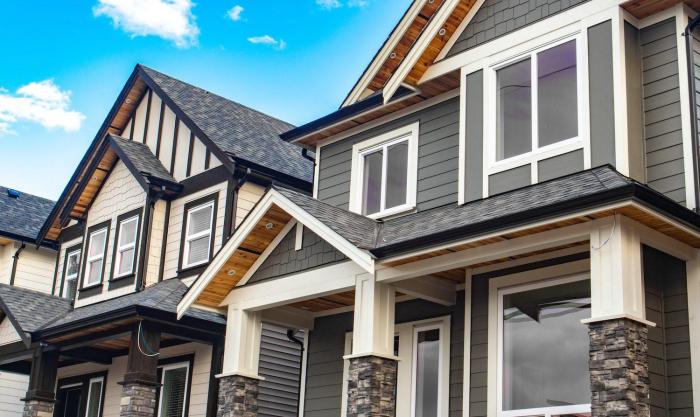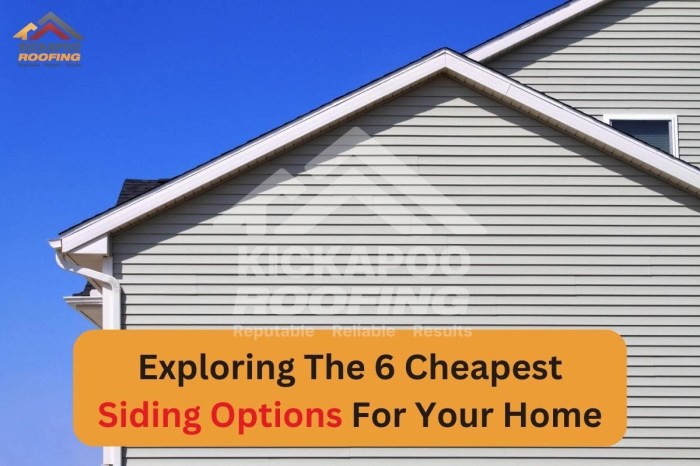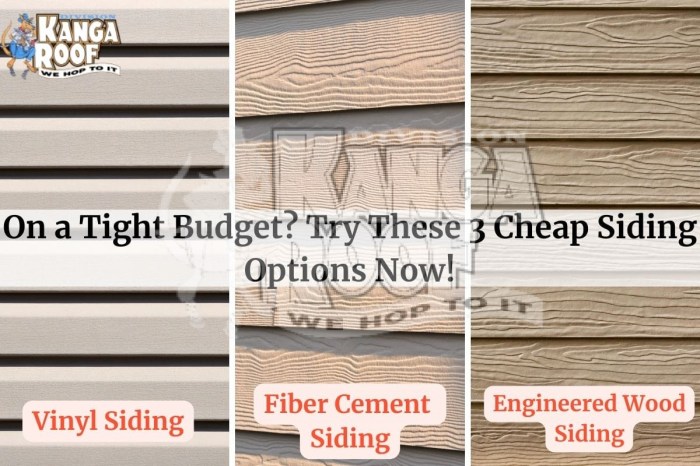Exploring Affordable Home Siding Options: A Comprehensive Guide
Embark on a journey through the realm of affordable home siding options, where we uncover the myriad choices available to homeowners looking to revamp their exteriors. From traditional materials to modern innovations, this guide delves into the pros and cons of each option, providing valuable insights to aid in your decision-making process.
As we navigate through the various types of siding materials, installation methods, and factors to consider, you'll gain a deeper understanding of how to enhance your home's curb appeal without breaking the bank.
Types of Affordable Home Siding Options

When it comes to affordable home siding options, there are several materials to consider. Each type has its own pros and cons, so it's important to weigh them carefully before making a decision. Two popular choices are vinyl siding and fiber cement siding, known for their durability and cost-effectiveness.
Vinyl Siding
- Pros:
- Cost-effective
- Low maintenance
- Wide range of colors and styles
- Cons:
- Prone to cracking and fading over time
- Not as environmentally friendly as other options
Fiber Cement Siding
- Pros:
- Durable and long-lasting
- Resistant to fire, insects, and rot
- Low maintenance
- Cons:
- Higher initial cost compared to vinyl siding
- Requires professional installation
Overall, while vinyl siding is more cost-effective upfront, fiber cement siding offers greater durability and longevity. It's essential to consider your budget and long-term maintenance needs when choosing the right siding material for your home.
Factors to Consider when Choosing Affordable Home Siding

When selecting affordable home siding options, there are several factors to consider to ensure you make the right choice for your home. Factors such as climate, maintenance requirements, and energy efficiency should all be taken into account.
Impact of Climate on Siding Materials
Different climates require different siding materials to withstand the elements effectively. For example, in areas with high humidity, vinyl siding is a popular choice as it is resistant to moisture and does not rot or warp. In colder climates, fiber cement siding is a durable option that can withstand freezing temperatures without cracking.
It is important to choose a siding material that can handle the specific weather conditions in your region to ensure longevity and performance.
Maintenance Requirements for Affordable Siding Options
The maintenance needs of different siding materials vary, so it is essential to consider how much time and effort you are willing to invest in upkeep. For example, vinyl siding is low maintenance and only requires occasional cleaning with soap and water to keep it looking new.
On the other hand, wood siding needs regular painting or staining to prevent rot and decay. Understanding the maintenance requirements of each siding material can help you choose one that fits your lifestyle and budget.
Impact of Siding Color on Energy Efficiency
The color of your home's siding can also impact its energy efficiency. Lighter colors reflect sunlight and heat, keeping your home cooler in the summer months and reducing the need for air conditioning. On the other hand, darker colors absorb heat, which can lead to higher indoor temperatures and increased energy consumption.
When selecting a siding color, consider how it will affect your home's energy efficiency and choose a shade that aligns with your climate and energy-saving goals.
Installation Methods for Affordable Home Siding
When it comes to installing affordable home siding, there are a few key methods to consider. Whether you choose to tackle the project yourself or hire a professional, the installation process can greatly impact the overall cost and effectiveness of your siding.
DIY Installation of Vinyl Siding
Installing vinyl siding can be a cost-effective option for homeowners looking to enhance the appearance and durability of their homes. Here is a step-by-step guide for a DIY installation of vinyl siding:
- Start by preparing the surface of your home by cleaning it thoroughly and making any necessary repairs.
- Measure and cut the vinyl siding panels to fit the dimensions of your walls, ensuring a proper fit.
- Begin installing the siding at the bottom of the wall, securing each panel in place with nails or screws.
- Overlap each panel slightly to create a seamless appearance and ensure proper insulation.
- Continue working your way up the wall, making sure to leave space for expansion and contraction.
- Finish the installation by adding trim pieces around windows, doors, and corners for a polished look.
Cost Differences between Professional Installation and DIY Projects
While DIY installation of siding can save you money on labor costs, it's important to consider the potential risks and challenges that come with tackling the project yourself. Hiring a professional installer may result in a higher upfront cost, but it can ensure that the siding is properly installed and provide peace of mind knowing the job was done correctly.
Importance of Proper Insulation
Proper insulation is crucial when installing affordable siding options to help regulate the temperature inside your home and improve energy efficiency. Without adequate insulation, your home may be more susceptible to heat loss in the winter and heat gain in the summer, leading to higher energy bills and reduced comfort.
Be sure to consider the insulation requirements for your chosen siding material and follow best practices for installation to maximize the benefits of your new siding.
Enhancing Curb Appeal with Affordable Home Siding
When it comes to enhancing the curb appeal of your home with affordable siding options, there are several creative ideas you can consider. Incorporating texture and patterns, mixing siding materials, and paying attention to trim and accents can all contribute to a visually appealing exterior.
Incorporating Texture and Patterns
Adding texture and patterns to your home's exterior can create visual interest and depth. Consider using vinyl siding with a wood grain texture or opting for fiber cement panels that mimic the look of natural stone. These affordable options can give your home a high-end appearance without breaking the bank.
Mixing Siding Materials
Mixing different siding materials can add dimension and character to your home's facade. For example, combining vinyl siding with stone or brick accents can create a striking contrast that draws the eye. You can also mix horizontal and vertical siding panels for a modern and unique look.
Trim and Accents
Trim and accents play a crucial role in complementing your choice of affordable siding. Opt for trim in a contrasting color to make your siding pop, or add decorative accents like corbels or shutters for a touch of elegance. These small details can make a big impact on the overall aesthetic of your home.
Last Point

In conclusion, the world of affordable home siding options offers a plethora of opportunities to elevate the aesthetic appeal and functionality of your residence. By carefully weighing the factors discussed in this guide, you can make an informed choice that not only enhances your home's exterior but also fits your budget and lifestyle.
Common Queries
What are the most cost-effective home siding materials?
Vinyl and engineered wood are often considered the most budget-friendly options for home siding.
How does climate influence the choice of siding materials?
Climate plays a significant role in determining the durability and performance of siding materials. For example, fiber cement siding is more suitable for areas with extreme weather conditions.
Is it possible to install siding on my own?
Yes, DIY installation is feasible for certain types of siding like vinyl. However, professional installation ensures a higher level of precision and expertise.
Can mixing different siding materials enhance my home's visual appeal?
Absolutely! Combining various textures and patterns can create a unique and eye-catching look for your home's exterior.




